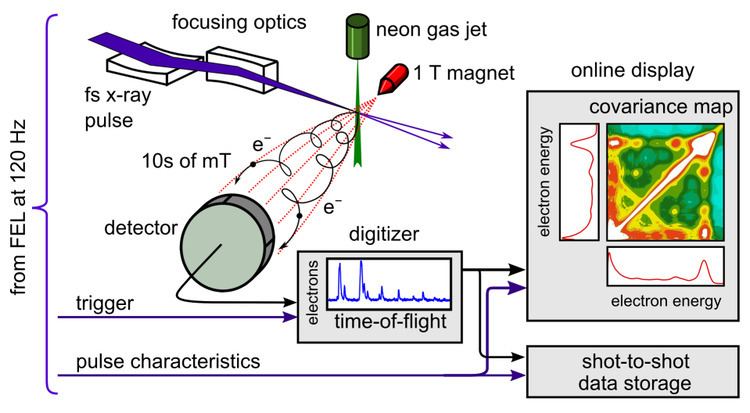 | ||
In statistics, covariance mapping is an extension of the covariance concept from random variables to random functions. Normal covariance is a scalar (a single number) that measures statistical relation between two random variables. Covariance maps are matrices (arrays of numbers) that show statistical relations between different regions of random functions. Statistically independent regions of the functions show up on the map as zero-level flatland, while positive or negative correlations show up, respectively, as hills or valleys.
Contents
Simple covariance mapping
Covariance mapping can be applied to any repetitive, fluctuating signal to reveal information hidden in the fluctuations. This technique was first used to analyse mass spectra of molecules ionised and fragmented by intense laser pulses.
Covariance mapping is particularly well suited to free-electron laser (FEL) research, where the x-ray intensity is so high that the large number of photoelectron and photoions produced at each pulse overwhelms simpler coincidence techniques. Figure 1 shows a typical experiment. X-ray pulses are focused on neon atoms and ionise them. The kinetic energy spectra of the photoelectrons ejected from neon are recorded at each laser shot using a suitable spectrometer (here a time-of-flight spectrometer). The single-shot spectra are sent to a computer, which calculates and displays the covariance map.
The need for correlations
Even in a relatively simple system, such as the neon atom, intense x-rays induce a plethora of ionisation processes (see Fig. 2). As the kinetic energies of the electrons ejected in different processes largely overlap, it is impossible to identify these processes using simple photoelectron spectrometry. To do so, one needs to correlate the kinetic energies of the electrons ejected in a given process. Covariance mapping is a method of revealing such correlations.
The principle
Consider a random function
The simplest way to analyse the data is to average the spectra over
Such spectra show kinetic energies of individual electrons but the correlations between the electrons are lost in the process of averaging. To reveal the correlations we need to calculate the covariance map:
where vector
How to read the map
The covariance map obtained in the FEL experiment is shown in Fig. 3. Along the x and y axes the averaged spectra
The volumes of the islands are directly proportional to the relative probabilities of the ionisation processes. This useful quality of the map follows from a property of the Poisson distribution, which governs the number of neon atoms in the focal volume and the number of electrons produced at a particular energy,
On the diagonal of the map there is an autocorrelation line. It is present there because the same spectra are used for the x and y axes. Thus, if an electron pulse is present at a particular energy on one axis, it is also present on the other axis giving the variance signal along the
Much more information is present on the map than on the averaged, 1D spectrum. The single, often broad and indistinct peaks on the 1D spectrum are resolved into several islands on the map. Fig. 4 shows magnified core-core and core-valence regions with several ionisation sequences identified unambiguously. In the DKV process the two electrons ejected share arbitrarily the energy available from a single proton producing a conspicuous line Ex + Ey = const in the left panel of Fig. 4. Impurities, such as water vapour or nitrogen, give islands usually away from the islands of the species studied (see Fig. 3b,e,f).
Partial covariance mapping
Covariance maps expose all kinds of correlations, including indirect ones that are induced by a fluctuating common parameter. Such common-mode correlations are often uninteresting and they obscure the interesting ones. For example, in the laser experiments the pulse intensity may fluctuate from shot to shot. These fluctuations correlate every electron with every other electron, simply because a more intense pulse produces more electrons of every energy.
Removal of uninteresting correlations
The influence of such uninteresting correlations can be removed using partial covariance mapping. This method exposes only a part of the correlations, the part that is independent of the fluctuating parameter
where
Stages of partial covariance mapping
It is instructive to see how this formula works on an example of another experiment performed at the FLASH FEL in Hamburg. (In fact this method was also used to analyse the LCLS experiment described above, but to keep the Wikipedia description simple the partial covariance was not mentioned.) The FLASH experimental setup was very similar to the LCLS setup shown in Fig. 1, except molecular nitrogen was studied and its ions rather than electrons were detected. Fig. 5a shows the correlated product
